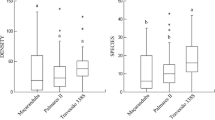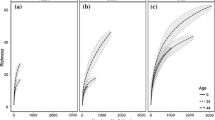Abstract
A multidisciplinary experimental research programme has run since 1997 at an experimental test area on the Hohenlohe plain near Forchtenberg, southwest Germany, where a 3.5 ha area of a mixed Carpinus betulus, Fraxinus excelsior, Acer pseudoplatanus and Fagus sylvatica forest is being used to research into questions on the early steps of cultural landscape development in Central Europe. The experiments which are being conducted here include forest clearance, burning and cultivation, as well as the recording of the succession stages of vegetation and soil. With respect to vegetation development, the first stage is that of ordinary regrowth, starting with colonisation by grasses and herbs followed by a shrub cover, its topping by pioneer trees or by their re-growth from stumps, leading to a new tree layer. The first stages of this forest regeneration are already visible in the third year after felling, with respect to vegetation as well as soil surface development. The alternative pathway of regeneration of the vegetation is represented as the “ruderal way”, which is characterised by a monotypic colonisation by high forbs such as Eupatorium, Epilobium or mostly Cirsium, which slows the development of a shrub cover. Topsoil and soil surface recovery goes parallel to that of vegetation. A first stage of pellicular soil surfaces is followed by grass felts and later on by leaf overlays which are often mixed with bare crumbly surfaces as signs of rapid turnover. Charcoal may either be displaced by earthworms or concentrated and weathered in situ by the soil microfauna of enchytraeids, mites and collembols. Charcoal also records the earlier cultivation by forming an Ap horizon. The development of ruderal vegetation within the forest environment should be considered when reconstructing the development of cultural landscapes.



















Similar content being viewed by others
References
Autorenkollektiv (2006) Spezialuntersuchungen der Vegetation in ausgewählten Naturwaldreservaten und bewirtschafteten Vergleichsflächen. Vegetationskundliche Untersuchungen auf ausgewählten Windwurfflächen, darunter im Naturwaldreservat Rotenberghang, Forstamt Kaiserslautern und Naturwaldreservat Himbeerberg, Forstamt Saarburg. Landesforstamt Rheinland-Pfalz. www.wald-rip.de/fileadmin/website/fawfseiten/fawf/downloads/Projekte/vegetation_2006_137.pdf. Accessed 13 Sept 2013
Belnap J, Lange OL (eds) (2001) Biological soil crusts: structure, function and management. (Ecological Studies 150) Springer, Berlin
Blackford JJ (2000) Charcoal fragments in surface samples following a fire and the implications for interpretation of subfossil charcoal data. Palaeogeogr Palaeoclimatol Palaeoecol 164:33–44
Bogaard A (2002) Questioning the relevance of shifting cultivation to Neolithic farming in the loess belt of Europe: evidence from the Hambach Forest experiment. Veget Hist Archaeobot 11:155–168
Bogenrieder A, Hügin G, Kury B (2005) Aktuelle Vegetation und Diasporenbank der prospektiven Brandflächen des Anbauversuchs Forchtenberg. Materialh Archäol 73:101–198
Brandes D (2012) Ruderal-vegetation. www.ruderal-vegetation.de/wasistdas.html. Accessed 20 June 2013
Bührle R, Dohle D, Eisele J, Gebala A, Rabus W, Reinhard H (2011) Einfluss von Brandrodung auf Oberbodeneigenschaften. Das Forchtenberg-Projekt. Integriertes bodenwissenschaftliches Projekt für Fortgeschrittene (3101-430). Universität Hohenheim, Institut für Bodenkunde und Standortslehre, Stuttgart
Buis E, Veldkamp A, Boeken B, Van Bremen N (2009) Controls of plant functional surface cover types along a precipitation gradient in the Negev Desert of Israel. J Arid Environ 73:82–90
Carcaillet C, Talon B (1995) Aspects taphonomiques de la stratigraphie et de la datation de charbons de bois dans les sols: exemple de quelques sols des alpes. Géog Phys Quatern 50:233–244
Certini G (2005) Effects of wildfire on properties of forest soils: a review. Oecologia 143:1–10
Clark JS (1988) Particle motion and the theory of charcoal analysis: source area, transport, deposition and sampling. Quat Res 30:67–80
Clark JS, Merkt J, Müller H (1989) Post-glacial fire, vegetation, and human history on the northern alpine forelands, south-western Germany. J Ecol 77:897–925
Dierschke H (1988) Pflanzensoziologische und ökologische Untersuchungen in Wäldern Süd-Niedersachsens. IV. Vegetationsentwicklung auf längerfristigen Dauerflächen von Buchenwald-Kahlschlägen. Tuexenia 8:307–326
Eckmeier E, Rösch M, Ehrmann O, Schmidt MW, Schier W, Gerlach R (2007) Conversion of biomass to charcoal and the carbon mass balance from the slash- and -burn experiment in a temperate deciduous forest. Holocene 17:539–542
Eckmeier E, Pätzold S, Lehndorff E, Gerlach R (2011) Geochemische Untersuchungen von Böden zur Rekonstruktion der prähistorischen Landnutzungsgeschichte. In: Bork R, Meller H, Gerlach R (eds) Umweltarchäologie. (Tagungen des Landesmuseums für Vorgeschichte Halle, Saale 6). Beier & Beran, Langenweißbach, pp 37–45
Ehrmann O, Rösch M, Schier W (2009) Experimentelle Rekonstruktion eines jungneolitischen Waldfeldbaus mit Feuereinsatz. Ein multidisziplinäres Forschungsprojekt zur Wirtschaftsarchäologie und Landschaftsökologie. Prähist Zschr 84:44–72
Ellenberg H (1978) Vegetation Mitteleuropas mit den Alpen, 2nd edn. Ulmer, Stuttgart
Fischer A, Abs G, Lenz F (1990) Natürliche Entwicklung von Waldbeständen nach Windwurf. Ansätze einer „Urwaldforschung“ in der Bundesrepublik. Forstw Centralbl 109:309–326
Fischer T, Veste M, Wiehe W, Lange P (2010) Water repellency and pore clogging at early successional stages of microbiotic crust on inland dunes, Brandenburg, NE-Germany. Catena 80:47–52
Gerlach R, Hilgers A (2011) Grubenfüllungen als archäologische Quelle. In: Bork R, Meller H, Gerlach R (eds) Umweltarchäologie. (Tagungen des Landesmuseums für Vorgeschichte Halle, Saale 6). Beier & Beran, Langenweißbach, pp 27–36
Glaser B (2007) Prehistorically modified soils of central Amazonia: a model for sustainable agriculture in the twenty-first century. Phil Trans R Soc B 262:87–196
Goldberg P, Macphail R (2006) Practical and theoretical geoarchaeology. Blackwell, Oxford
Hartkopf-Fröder C, Ehrmann O, Eckmeier E, Gerlach R, Dauber S, Jasper K, Littke R (2012) Reflectance of Forchtenberg charcoals: implications for fire temperature and preservation potential. In: Ehrmann O, Kury B (eds) Farming in the forest: ecology and economy of fire in prehistoric agriculture. 3rd International Schöntal Conference, Kloster Schöntal, abstract volume
Herrmann L, Ehrmann O, Stein C, Wembter N, Schulz E, Rösch M, Hall M, Bogenrieder A, Page H, Schier W (2007) The Forchtenberg project. An interdisciplinary experimental approach towards neolithic agriculture. Atti Soc tosc Sci Nat Mem Ser A 112:127–132
Lüning J (2000) Steinzeitliche Bauern in Deutschland. Die Landwirtschaft im Neolithikum. (UPA 58) Habelt, Bonn
Lüning J, Meurers-Balke J (1980) Experimenteller Getreidebau im Hambacher Forst, Gemeinde Elsdorf, Kr. Bergheim/Rheinland. Bonner Jb 180:305–344
Macphail R, Cruise GM, Allen MJ, Linderholm J, Reynolds P (2004) Archaeological soil and pollen analysis of experimental floor deposits; with special reference to Butzer Ancient Farm, Hampshire, UK. J Archaeol Sci 31:175–191
Mayer M (2012) Sondierende Untersuchung an der spätlatènezeitlichen Siedlung von Waltersdorf, Ldkr. Drehn-Spreewald. Ufg.geschichte-hu-berlin.de/site/lang_de/4199default/qeps. Accessed 20 June 2013
Merkt J, Müller H (1995) Laminated sediments in South Germany from the Neolithic to the Hallstatt Period. Pact 41(II):101–116
Mertz P (2002) Pflanzenwelt Mitteleuropas und der Alpen. Nikol, Hamburg
Meurers-Balke J, Lüning J (1990) Experimente zur frühen Landwirtschaft. Exp Archäol Dtschl 4:82–92
Ohlson M, Tryterud E (2000) Interpretation of the charcoal record in forest soils: forest fires and their production and deposition of macroscopic charcoal. Holocene 10:519–525
Pomel S (2008) La mémoire des sols. Presses Universitaires de Bordeaux, Bordeaux
Reynolds PJ (1977) Slash and burn experiment. Archaeol J 134:307–318
Rösch M (1993) Prehistoric landuse as recorded in a lake-shore core at Lake Constance. Veget Hist Archaeobot 2:213–232
Rösch M (2005) Anbauversuche in Hohenlohe. Fragestellungen, wissenschaftlicher Ansatz. Materialh Archäol 73:67–81
Rösch M (2010) Landnutzung, Pflanzenproduktion und Sammelwirtschaft. In: Badisches Landesmuseum Karlsruhe (ed) Jungsteinzeit im Umbruch: die “Michelsberger Kultur” und Mitteleuropa vor 6000 Jahren. Primus, Darmstadt, pp 164–168
Rösch M, Biester H, Bogenrieder A, Eckmeier E, Ehrmann O, Gerlach R, Hall M, Hartkopf-Fröder C, Herrmann L, Kury B, Schier W, Schulz E (2011) Spätneolithischer Ackerbau im Experiment - eine Zwischenbilanz nach zwölf Jahren Forchtenberg. In: Bork R, Meller H, Gerlach R (eds) Umweltarchäologie. (Tagungen des Landesmuseums für Vorgeschichte Halle, Saale 6). Beier & Beran, Langenweißbach, pp 175–192
Rukkolainen L, Salo K (2006) The succession of boreal forest vegetation during ten years after slash-burning in Koli National Park, eastern Finland. Ann Bot Fennici 43:363–378
Schier W (2009) Extensiver Brandfeldbau und die Ausbreitung der neolithischen Wirtschaftsweise in Mitteleuropa und Südskandinavien am Ende des 5. Jahrtausends v. Chr. Prähist Zschr 84:15–43
Schulz E (1994) Indicateurs de l′influence anthropique sur la végétation actuelle et passée. Régions mediterranéennes, subtropicales et tropicales. In: Maire R, Pomel S, Salomon J-N (eds) Enregistreurs et indicateurs de l′evolution de l′environnement du zone tropicale. (Espaces tropicaux 13). Presses universitaires de Bordeaux, Bordeaux, pp 129–142
Schulz E (2005) Nach schwerem Eingriff. Die Regeneration von Boden und Vegetation nach Rodung. Brand und Anbau im Experiment. Materialh Archäol 73:141–160
Schulz E, Bogenrieder A, Ehrmann O, Hall M, Herrmann L, Rösch M, Schier W (2005) How many years it will take? The regeneration of soil and vegetation after clearing, burning and cultivation. The development of cultural landscape in experiment. Annalele Universitatii din Oradea, Seria Geografie, Oradea 15:130–140
Stähr F (2012) Wie Phönix aus der Asche - Sekundärsukzession nach Waldbrand als Grundlage für die Entwicklung von Wirtschaftswald? Ebersw Forstw Schrreihe 49:10–22
Topoliantz S, Ponge JF (2005) Charcoal consumption and casting activity by Pontoscolex corethrurus (Glossoscoleidae). Appl Soil Ecol 28:217–227
Topoliantz S, Ponge J-F, Viaux P (2000) Earthworm and enchytraeid activity under different arable farming systems, as exemplified by biogenic structures. Plant Soil 225:39–51
Topoliantz S, Ponge J-F, Lavelle P (2006) Humus components and biogenic structures under tropical slash-and-burn agriculture. Europ J Soil Sci 57:269–278
Ullmann I, Büdel B (2001) Ecological determinants of species composition of biological soil crusts on a landscape scale. In: Belnap J, Lange OL (eds) Biological soil crusts: structure, function and management. (Ecol Stud 150). Springer, Berlin, pp 202–213
Varela ME, Benito E, Keizer JJ (2010) Effects of wildfire and laboratory heating on soil aggregate stability of pine forests in Galicia: the role of lithology, soil organic matter content and water repellence. Catena 83:127–134
Weigmann G (1998) Bodenfauna. In: Blume HP, Felix-Henningsen P, Frede H-G, Guggenbauer G, Horn R, Stahr K (eds) Handbuch der Bodenkunde. 2.4.11, 5. Erg.Lfg. Eco-Verlag, Wiesbaden, pp 1–20
Zachariae G (1994) Welche Bedeutung haben Enchytreen im Waldboden? In: Jongerius A (ed) Soil micromorphology. Elsevier, Amsterdam, pp 57–67
Zachrisson O, Nilsson M-C, Wardle DA (1996) Key ecological function of charcoal from wildfire in the boreal forests. Oikos 77:10–19
Acknowledgments
We are grateful to the Würth and Stoll-Vita Foundations as well as to the Deutsche Forschungsgemeinschaft (DFG) for financial support. We also thank J. Rückert for help with the English language. Thanks also go to two anonymous reviewers for their helpful suggestions.
Author information
Authors and Affiliations
Corresponding author
Additional information
Communicated by R. Gerlach.
Rights and permissions
About this article
Cite this article
Schulz, E., Vannina, U. & Hall, M. The double mosaic-regeneration of vegetation and soil after clearing, burning, and cultivation: lessons from the Forchtenberg experiment. Veget Hist Archaeobot 23 (Suppl 1), 19–36 (2014). https://doi.org/10.1007/s00334-014-0451-5
Received:
Accepted:
Published:
Issue Date:
DOI: https://doi.org/10.1007/s00334-014-0451-5




